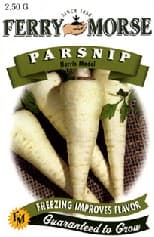How to Grow Parsnips in Your Garden

About How to Grow Parsnips Plant
Parsnips may not be overly popular in today’s home gardens. But, this root crop has been grown in vegetable gardens for thousands of years. Parsnip is native to the Mediterranean and North Africa, where early Greeks and Romans grew parsnips. As you read this article on how to grow parsnips, we hope it incents you to buy some parsnip seeds and try them out in your home garden. Then, you’ll be like the Greek and Romana gods.
Parsnips are members of the carrot family. They a root crop, that looks like a carrot, only it grows much bigger and is white. The plants can reach 3 feet tall. The roots generally grow 12-15 inches. But, the largest ones, have grown to 32 inches and 10-18 inches in diameter. Now, that’s a big parsnip!
Did You Know? In Ireland, beer was made from parsnip roots, by boiling the roots with water and hops.
Botanical Name: Pastinaca Sativa
Planting Parsnip Seeds
Sow Parsnip seeds 1/2 inch deep. The big seeds are easy to handle and space.
Final spacing should be 6 – 82 inches apart, in rows two feet apart.
Sow seeds early in the spring. Plants take 4 months to reach harvest size.
Space plants one foot apart, in rows 2 to 2 1/2 feet apart.
Ideal soil ph: 5.5 – 7.5 More on soil pH
How to Grow Parsley - Season Long Care
Tips for Growing Parsnips:
Work the soil deeply. Remove all rocks and stones.
Loose soil is very important. Add plenty of compost, but no manure.
Do not add too much nitrogen fertilizer. It results in “hairy” roots.
Water deeply, as the roots grow quite deep over the long season.
Grow plants in full sun, in soft and loose loam soil.
Ideal pH: 5.5 – 6.5. More on soil pH
Before planting parsnip seeds, work the soil deeply. Add liberal amounts of compost. If compost is not available, add peat moss. It is important to remove any rocks, stones, and debris that may impede the downward formation of the roots. When a root hits an object, forked or misshapen roots will result.
Keep the plants well weeded early in the season. Young seedlings are easily overcrowded, with any competing weeds often winning out.
While they may not show it, parsnips need a good supply of water, in soil that drains well. Water deeply once a week, especially during dry periods.
They also respond well to fertilizer applied before sowing parsnip seeds and a couple of times during the season. Importantly, do not over fertilizer the plants. Too much nitrogen in the soil results in hairy (fine feeder roots) roots.
Also, see:
Soil Temperatures – Ideal germination temperature by vegetable
Ideal Soil pH: 5.5 – 7.5.
Insects and Pests
Occasionally root maggots can be a problem. Swallow Tail Butterfly caterpillars can also be a problem. Handpick them, when you see them.
Parsnip Plant Disease
The plants are relatively free of disease problems.
How to Grow Parsnips - Harvest Time
Days to Harvest: Approximately 130 days or more. The roots are slow growing.
Harvest roots after they have been exposed to freezing temperatures. Cold weather improves flavor and sweetness, as the starches turn to sugars. This is why Parsnips taste better after the first freeze. Better still, wait for the first several days of at or near freezing weather
Do not grab the plant to pull out the roots. The plant will almost always break away from the roots. Rather, dig out roots with a shovel or pitchfork.
Parsnips are excellent for over-wintering in the soil. You should be able to harvest roots well into the spring. Cover the area with mulch or straw, to keep the ground from freezing.
Plant Hardiness
Parsnip plants are hardy. The plant should survive a light frost or freeze. They need a long growing season to allow the roots to grow to full size.
Did You Know? Before refrigerators, people stored parsnip roots in the ground. Straw or dead leaves are piled on the ground to insulate them and keep them from freezing. When you want some parsnips, just dig them up out of the garden
Parsnip Recipes
May we suggest:
Related Articles
Also, people who liked this article like:
Growing Celery – even more information from Garden Hobbies
Please support our site. Shop for:
- rmmatthews100@hotmail.com
- 585-721-6528
- Rochester, NY
©1999-2024 GardenersNet.Com, All Rights Reserved

